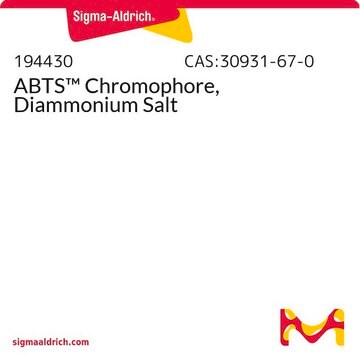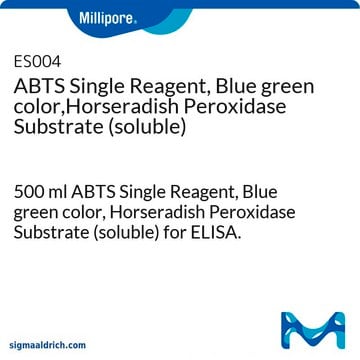A9941
2,2′-Azino-bis(3-ethylbenzothiazoline-6-sulfonic acid) diammonium salt
chromogenic, tablet
Synonym(s):
AzBTS-(NH4)2, Diammonium 2,2′-azino-bis(3-ethylbenzothiazoline-6-sulfonate)
About This Item
Recommended Products
product name
2,2′-Azino-bis(3-ethylbenzothiazoline-6-sulfonic acid) diammonium salt, tablet, 10 mg substrate per tablet
form
tablet
solubility
deionized water: 100 mL
storage temp.
room temp
SMILES string
[NH4+].[NH4+].CCN1C(\Sc2cc(ccc12)S([O-])(=O)=O)=N\N=C3/Sc4cc(ccc4N3CC)S([O-])(=O)=O
InChI
1S/C18H18N4O6S4.2H3N/c1-3-21-13-7-5-11(31(23,24)25)9-15(13)29-17(21)19-20-18-22(4-2)14-8-6-12(32(26,27)28)10-16(14)30-18;;/h5-10H,3-4H2,1-2H3,(H,23,24,25)(H,26,27,28);2*1H3/b19-17-,20-18-;;
InChI key
OHDRQQURAXLVGJ-AXMZSLBLSA-N
Looking for similar products? Visit Product Comparison Guide
General description
ABTS, 2,2′-Azino-bis(3-ethylbenzthiazoline-6-sulfonic acid), is a chromogenic substrate used:
- For a reaction with laccase or bilirubin oxidase
- For a reaction with peroxidase enzymes: (like HRP for example). ABTS in combination with hydrogen peroxide
ABTS, 2,2′-Azino-bis(3-ethylbenzothiazoline-6-sulfonic acid) diammonium salt is light sensitive, and water soluble chemical compound
Application
- 2,2′-Azino-bis(3-ethylbenzothiazoline-6-sulfonic acid) diammonium salt, ABTS, has been used as a substrate in ELISA (enzyme-linked immunosorbent assay).†
- ABTS is also used to measure glucose concentrations in different solutions including blood serum.
- The food industry uses ABTS to measure the antioxidant capacities within different foods.
- Since it is less readily oxidized than TMB and OPD substrates, ABTS is less sensitive for ELISA applications. Thus ABTS has some advantageous over TMB and OPD in cases of large background results
- It is recommended for ELISA (microwell) procedures, not recommended for membrane applications.
Reconstitution
Storage Class Code
11 - Combustible Solids
WGK
WGK 3
Flash Point(F)
Not applicable
Flash Point(C)
Not applicable
Personal Protective Equipment
Certificates of Analysis (COA)
Search for Certificates of Analysis (COA) by entering the products Lot/Batch Number. Lot and Batch Numbers can be found on a product’s label following the words ‘Lot’ or ‘Batch’.
Already Own This Product?
Find documentation for the products that you have recently purchased in the Document Library.
Customers Also Viewed
Articles
NBT-BCIP substrate system aids in western blotting and immunohistological staining, producing a blue-purple insoluble end product.
NBT-BCIP substrate system aids in western blotting and immunohistological staining, producing a blue-purple insoluble end product.
NBT-BCIP substrate system aids in western blotting and immunohistological staining, producing a blue-purple insoluble end product.
NBT-BCIP substrate system aids in western blotting and immunohistological staining, producing a blue-purple insoluble end product.
Protocols
To measure alcohol oxidase activity, this assay uses 2,2′-azino-bis-(3-ethylbenzothiazoline-6-sulfonic acid) and a continuous spectrophotometric rate determination at 405 nm.
To measure alcohol oxidase activity, this assay uses 2,2′-azino-bis-(3-ethylbenzothiazoline-6-sulfonic acid) and a continuous spectrophotometric rate determination at 405 nm.
To measure alcohol oxidase activity, this assay uses 2,2′-azino-bis-(3-ethylbenzothiazoline-6-sulfonic acid) and a continuous spectrophotometric rate determination at 405 nm.
To measure alcohol oxidase activity, this assay uses 2,2′-azino-bis-(3-ethylbenzothiazoline-6-sulfonic acid) and a continuous spectrophotometric rate determination at 405 nm.
Our team of scientists has experience in all areas of research including Life Science, Material Science, Chemical Synthesis, Chromatography, Analytical and many others.
Contact Technical Service








